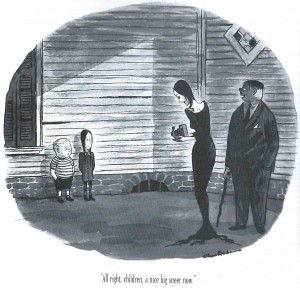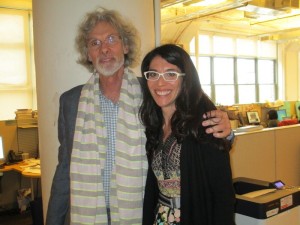
Expectations: I’ll admit I wasn’t too eager to watch this one, but I haven’t missed a premiere documentary yet so I will get it done. My procrastination is only because I know nothing about the New Yorker magazine. There is something positive to say about my expectations though and that is that I will be embarking on something new in this subject matter. It is always good to learn something new, isn’t it? I appreciate artistry and journalism so it is not going to hurt to learn about the types of people who become cartoonist are to learn about the process from this iconic magazine. Here is the trailer and I’ll resume my thoughts after taking in the eighty-five minute film.

“All right Children, a big sneer now.”
Gut Reaction: Okay, where were we? I guess the draw and fascination with this film is for those who revere the New Yorker and that isn’t me. Hell, I have never even seen one; I don’t even think I could find one in my rural hamlet if I wanted too. But, the periodical has been around since 1925 and everybody who is anybody reads it in NYC at least. Evidently, we learn that there are a number of people who strive to get there one-panel cartoons published within its pages as well. This film gives us a brief history of the magazine and its intent and how it tries to stay within the current times. We also get, and this is the best part, a strong sampling of the drawings through the years. Well, at least I have heard of Charles Addams! He created Gomez & Morticia and their brood, but I didn’t know that those mysterious and kooky characters started in this magazine nor did I know just how prestigious it is too be published.
The cartoons that grace the pages and are archived at the publishing offices are not political cartoons like shown in the HERBLOCK documentary, but sly & simply humorous panels that say a lot if you understand them. They tell a lot about the humor and sensibilities of the artists behind them. For me, that was the more interesting aspect of the film which comes as no surprise as most HBO documentaries I appreciate are examinations of human behavior and conditions. It isn’t until we meet some of the current submitters do I perk up. What do they find funny? What viewpoint of the world do they draw from in order to draw their styles of cartoons? What drives them to keep submitting drawings? Apparently it is not for money for most of them have day jobs. Their perspective and their stories added weight to the piece.
The rest of the film is taken up with the current cartoon editor Bob Mankoff (pictured). He enjoys this limelight and often breaks the forth wall to talk to the crew. He is eccentric and quirky and seems to be the type to be the first to admit it. His light-heartedness and his knowledge of humor and his insistence that the world needs humor to cope is a refreshing spin. It ended up being a painless time spent taking in the process.
Bonus: Here is an excerpt of an interview HBO had filmmaker Leah Wolchok (pictured w/ Mankoff).
HBO: What is your personal connection to the New Yorker’s cartoons, and what inspired you to make a documentary about them?
LEAH WOLCHOK: I am one of those people with the guilty stack of unread New Yorkers on my bedside table. I often felt so bad about not reading the articles, but I did flip through the cartoons. Right when I finished film school, the magazine launched their caption contest, and every week I would try to come up with something great, though generally I sucked. One week a caption came to me and I finally worked up the courage to submit it. Of course, I didn’t even make the finals; I learned later that my caption was one of hundreds of nearly identical lines that had been submitted, which is not that unusual. However, the contest got me thinking about the cartoons in a whole different way. Because I wasn’t good at it, I wanted to know about the people — the New Yorker cartoonists — who were.
HBO: How did you get your foot in the door at such a prestigious institution?
LW: I got Bob Mankoff’s email address and sent him a two-line email. This was a year after I finished film school, so it was pretty presumptuous on my part, but he called me the very next day. I was so nervous on the phone because I didn’t want him to get freaked out by how young I was.
I decided to attend the New Yorker festival where I met at least 20 different cartoonists. I fell in love with the cartoonists immediately — they were all so down to earth and accessible. I was really taken with the community. At the same time, I was meeting with Bob in his office, and while he was very charming, he said to me, “Who the hell do you think you are to come in here and think that you could make this film?” He shattered my ego momentarily, but I saw his cruelty as a challenge.
It was when one of the cartoonists, Matt Diffee, who suggested that I come and interview the cartoonists anyway because they were all independent artists. I put together a small crew of friends from film school and shot a series of interviews, and later had an editor cut them into a fundraising reel. That reel caught the attention of the Tribeca Film Institute Documentary Fund, which happened to be sponsored by HBO that year. Because TFI and HBO were behind me, that opened the door back up to the New Yorker and Bob.
HBO: What do you think makes the New Yorker cartoons so timeless? I was surprised by the number of young artists the magazine attracts.
LW: Bob once described the relationship between the cartoonists and the magazine as symbiotic: The New Yorker makes the cartoonists, but the cartoonists make the New Yorker. You
would think that publishing these single panel cartoons — one image, one line, very static — would be the last thing a young comic artist would want to do in this really dynamic digital age, but I believe it’s a reverence for tradition that brings them in. Once they’re published in the New Yorker and they become a New Yorker cartoonist, that validation helps them keep going.
In Conclusion: It was the combination of the personalities in this piece that made it entertaining enough. It doesn’t make me want to rush out to get the next issue of the New Yorker, but it does make me appreciate the artistic efforts that go into it. The biggest theme that I take away from it though is that of the importance that humor has in our society.
Next Week: A look of another iconic institution – Russia’s Bolshoi Ballet in BOLSHOI BABYLON debuting Monday, December 21 at 9:00pm.


 would think that publishing these single panel cartoons — one image, one line, very static — would be the last thing a young comic artist would want to do in this really dynamic digital age, but I believe it’s a reverence for tradition that brings them in. Once they’re published in the New Yorker and they become a New Yorker cartoonist, that validation helps them keep going.
would think that publishing these single panel cartoons — one image, one line, very static — would be the last thing a young comic artist would want to do in this really dynamic digital age, but I believe it’s a reverence for tradition that brings them in. Once they’re published in the New Yorker and they become a New Yorker cartoonist, that validation helps them keep going.